Migraine is severe, continuous, recurring and very painful headache. The extreme pain caused by it can last for hours or even days. Yoga for migraine can benefit a person by soothing, calming and preventing migraine attacks.
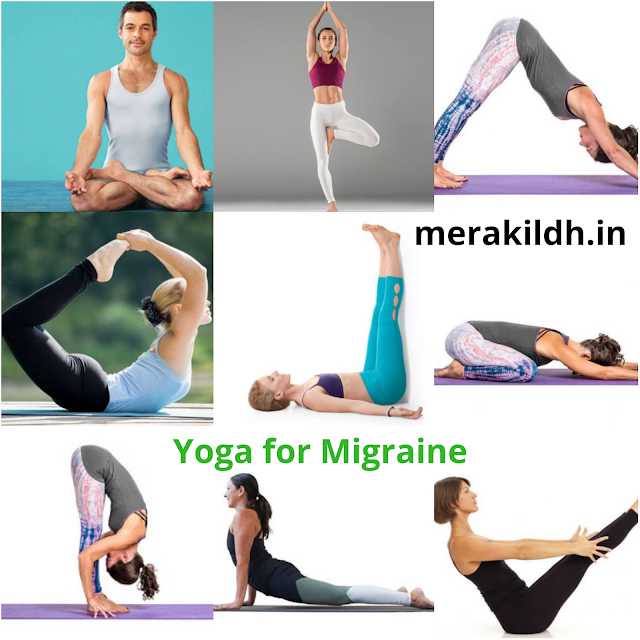 |
| Yoga for migraine |
It is frequently characterized by intense and low headaches. Symptoms of migraine include:
- Vomiting
- Difficulty in speaking
- Sensitivity to light
- Sensitivity to sound
Migraine can affect people of all ages. Some people also get a warning symptom before the migraine headache starts. People with migraine can prevent a full-blown attack by recognizing and acting upon the warning signs.
List of yoga for migraine
- Bow pose (Dhanurasana)
Procedure:
- First lie down on the mat in a prone position.
- Then Exhale your breath, bend your knees and hold the ankles with hands and while inhaling breath raise the thighs, head and chest as high as possible.
- Try to maintain body weight on the lower abdomen. Join the ankles.
- While exhaling, bring down the head and legs up to the knee joint.

Bow pose Benefits of Bow pose
- It stimulates the organs of the abdomen and the neck.
- It improves body posture.
- It strengthen the back muscles.
- Bow pose helps relaxing the mind.
- It takes away stress and also prevents migraine headaches.
- Lotus yoga pose (Padmasana)Procedure:
- Sit on the floor with extended legs, and straight back.
- Bend your right knee and embrace your chest with it.
- Then put your right ankle to your left hip’s crease, so that your right foot’s sole faces the sky. On your hip crease, the top of your foot should be resting.
- Now bend the left leg. Over the top of your right shin, cross your left foot. Your left foot’s sole should also face upwards, and your hip crease should rest on the top of your foot and ankle.
- Draw the knees together as close as possible. Force the buttocks toward the floor and sit straight down.
- Try to meditate in this position for at least 1 minute.

Lotus yoga pose Benefits of Lotus yoga pose
- Lotus pose helps relieve stress.
- It stretches the ankles and knees.
- Prevents migraine headaches by calming the brain.
- It makes the spine strong and straight.
- Reduce back pain.
- Tree Pose (Vriksasana)
Procedure:
- Stand in Tadasana as the beginning stage of the pose.
- Exhaling your breath, bend the right knee and place the right foot on the left thigh.
- When inhaling breath, raise the arms up and join the palms.
- Looking straight, maintain the pose for 5-6 time breathings and then repeat the procedure on the other side also.
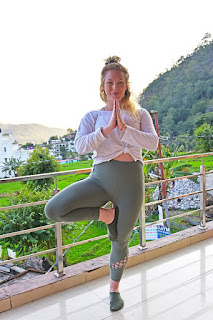
Tree pose Benefits of Tree Pose
- It stretches the thighs, torso, and shoulders.
- Improve body posture and body balance.
- Work as a stress buster.
- It helps to remedy flat feet.
- Calm both the mind and the body.
- Legs up the wall pose (Viparita Karani)
Procedure:
- First lie on the mat in a prone position and then take your both legs up straight against the wall and hold them there straight.
- While holding the pose, meditate for at least 1 minute to as long as you can.

Legs up the wall Benefits of Legs up pose
- It helps to Stretch the hamstrings and lower back.
- It helps relieve lower back tension.
- Soothe the mind and the body.
- Help to relieve stress and refreshes the mind.
- Good for people suffering from migraine, stress and anxiety.
- Child’s pose (Balasana)
Procedure:
- Position your hands and knees on the mat.
- Stretch out your knees and keep your feet firmly on the ground.
- Bend your body and relax your back by stretching your arms with palms on the ground in front of you.
- Hold this position as long as possible. For clarification about the pose see the photo below.

Child’s pose Benefits of Child’s pose
- Helpful in reducing back pain.
- Improve flexibility.
- Improve neck, spine and shoulders.
- Release stress, tension and anxiety.
- Refresh the mind and body.
- Downward facing dog (Adho mukha svanasana)Procedure:
- Firstly set your knees directly below your hips and your hands slightly forward to your shoulders.
- Spread your palms and turn your toes under.
- Exhale your breath and make your legs straight (take your knees up).
- Keep your back straight.

Downward facing dog Benefits of Downward facing dog
- Calms the brain.
- Helps to relieve stress and mild depression.
- Energizes the body.
- Stretches the shoulders, hamstrings, calves, arches, and hands.
- Strengthens the arms and legs.
- Wide-Legged forward bend (Prasarita Padottanasana)
Procedure:
- First start with your legs wide, feet should be parallel and toes turned slightly to protect your knees.
- Keep your legs straight and begin to bend forward at the hips.
- Adjust your body so you feel that your hips are over your ankles and your weight intends slightly forward into your toes.
- Hold this position as long as you can.
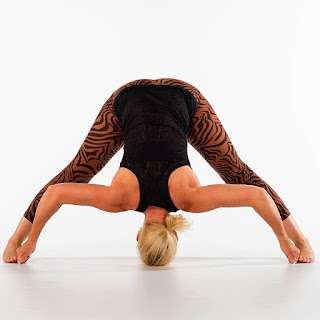
Wide-legged forward bend Benefits of Wide-Legged forward bend
- It improves your hip joint flexibility.
- It strengthens your feet.
- Soothe the mind and the body.
- It improves body posture.
- Good for depression, stress, and anxiety patients.
- Standing forward bend (Uttanasana)Procedure:
- First stand with your feet joined.
- Slightly bend your knees and fold your torso over your legs, moving from your hips, not the lower back.
- Place your hands in front of your feet. Inhale and extend your chest to lengthen the spine.
- Exhale your breath and keep your legs straight and extend your torso down without rounding your back.
- Stay in that position as long as you can. Then come back to starting position.
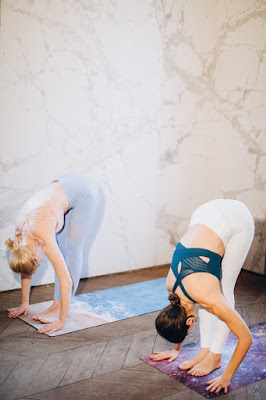
Standing forward bend Benefits of forward bend:
- It helps to calm your brain.
- It helps to relieve stress.
- It is great for mild depression.
- It Strengthen the thighs and knees.
- It improves digestion and cures constipation.
- Head to knee forward bend (Janushirsasana)Procedure:
- Sit on the ground keeping your legs straight.
- Fold your left leg such that left foot touches the right thigh.
- Now bend down so your forehead or nose touches the right knee.
- Hold this position as long as you can and come back. Repeat above steps with other leg.
Head to knee forward bend Benefits of head to knee forward bend
- It helps to reduce the belly fat.
- It reduces the knee pain.
- It strengthens the rib bones.
- Release stress, tension and, anxiety and makes a person stress-free.
- Seated forward bend yoga pose (Paschimottanasana)Procedure:
- Stretch your legs out and sit on the ground.
- Touch your feet’s thumbs with your palms, slowly respire, and try to put your head on your knees.
- Then lift your head slowly and return to your first spot. Perform this Asana for 5-10 minutes daily.
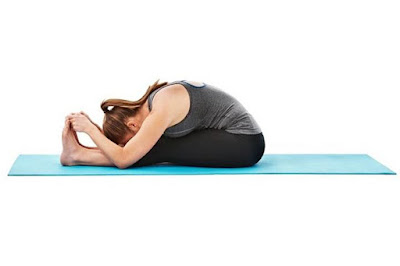
Seated forward bend yoga pose Benefits of seated forward bend yoga pose
- It calms the brain and retrieve the stress.
- It Stretches the spine and shoulders.
- It improves your digestion and cures constipation.
- It Soothes headache and anxiety.
- Seated forward bend pose also prevents migraine headaches.
- Lord of the Fishes Pose (Matsyendrasana)Procedure:
- Start in easy yoga pose.
- Take right leg over the left leg, place the right foot on the outside of the left knee and keep the toes of your right foot face forward.
- Now hold your leg with left arm as shown in the image.
- Hold this position for 1-2 minutes and come back to easy pose position.
- Then repeat above steps for your left leg.
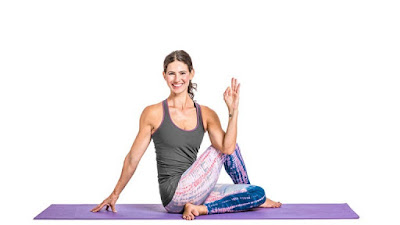
Lord of the fishes pose Benefits of Lord of the Fishes Pose
- It increases the flexibility.
- It cures constipation and improves digestion.
- It helps to increase the oxygen supply to the lungs.
- It is beneficial for slipped disc patients.
- Good for mental health.
- Matsyendrasana can prevent many problems like stress, anxiety and, migraine.
- Upward facing dog (Urdhva Mukha Svanasana or Bhujangasana)Procedure:
- To do this asana, lie on the ground on your stomach, place your hands close to the shoulders on the ground, lift the chest so your arms are fully extended, and do this while stretching your legs.
- Take the toes in and hang the head slowly behind.
- Slowly come in the initial position. Repeat this 3-5 times.

Upward facing dog Benefits of Upward facing dog
- Stretches the muscles of shoulders, and chest.
- Decreases stiffness of lower back.
- Strengthens the arms and shoulders.
- Increases flexibility.
- Invigorates the heart.
- Bhujangasana is very helpful for mental health.
- Bridge Pose (Setu Bandha Sarvangasana)Procedure:
- Lie on the floor on your back and keep your knees bent.
- Extend your arms along the floor and keep them flat. Press your feet and arms firmly into the floor.
- Exhale your breath as you lift your hips toward the ceiling.
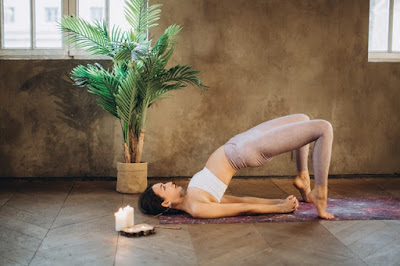
Bridge pose Benefits of Bridge Pose
- Stretches chest, neck, spine.
- Strengthens the back, buttocks, and hamstrings.
- Stretches hips.
- Improve blood circulation in the body.
- Relaxes the mind and prevent stress.
- Boat poseProcedure:
- Lie flat on your back on the mat with your arms by your side.
- Inhale and slowly raise your both legs and upper body up the ground. Only your sacral spine area (butt) should touch the ground.
- Hold the position as long as you can, exhale, and lie down back normally in savasana position.
Boat pose Benefits of Boat pose
- It strengthens hip and spine.
- It help to relieve stress.
- It is good for digestion and cures various problems like constipation.
- Relaxes the mind and help in avoiding the full-blown attack of migraine.
- Corpse Pose (Savasana)Procedure:
- Lie down on the back on the floor and completely relax the body. Take a long and deep breath.
- There should be a distance between your feet of at least 1 foot. Palms ought to be a little far from the body and look skyward.
- Close your eyes and imagine it’s soothing for your body.
- You will feel like your body is relaxing. Perform this asana for 5-10 minutes.
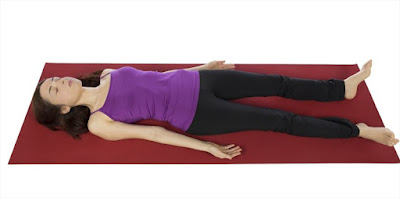
Corpse pose Benefits of Savasana
- It helps to calm the brain and help to relieve stress and mild depression.
- It helps to relax the body.
- It helps to reduce headache.
- It helps to lower blood pressure.
- Person suffering from migraine must perform this asana after completing exercise.
Tags health migraine yoga
